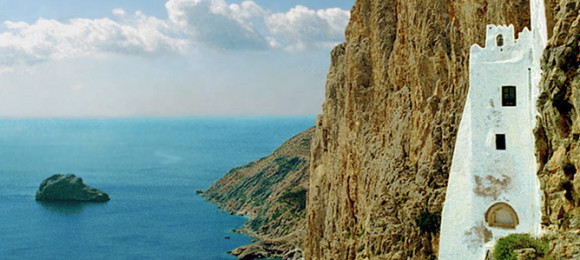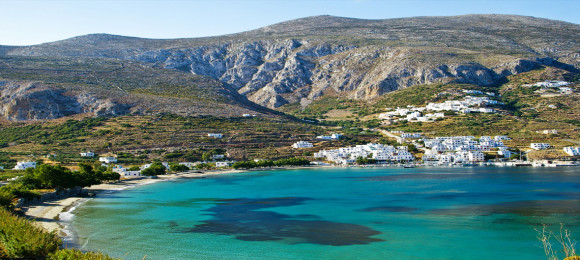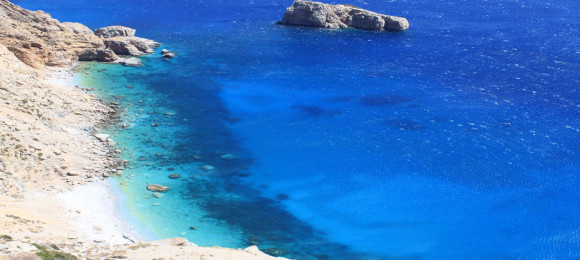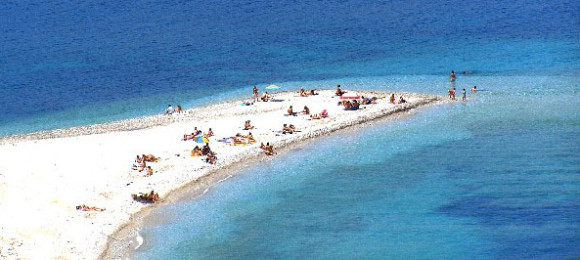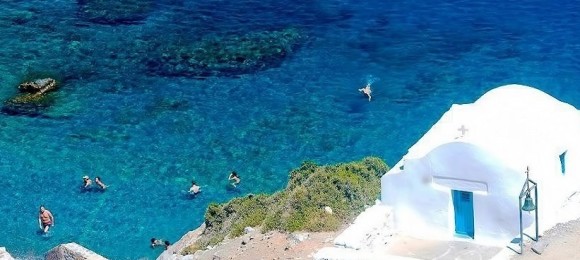Overview of Amorgos
The place where the film “The Big Blue” by Luc Besson was mainly shot is one of the most unpretentious and laid back Greek islands. Amorgos is a wild beauty located at the easternmost part of the Cyclades. It’s perfect for a relaxing vacation, gaining more and more loyal fans thanks to its uncommercialized character and alternative profile. The island boasts of a unique atmosphere, comprised of many things.
First of all, its morphology: Amorgos is mountainous, with rocky shores, caves and beautiful coves of crystalline blue waters. Furthermore, ancient relics, numerous churches, as well as the photogenic villages and Chora (one of the prettiest in the Greek islands) contribute to the island’s natural charm. Amorgos features two harbors: Katapola at the center and Egiali at the north. The latter is a popular touristic settlement frequented by all types of tourists, including many young people, due to the area’s camping site. Indeed, the island boasts of youth energy (and a joyful nightlife), but at the same time it remains peaceful and calm.
Amorgos also attracts adventure seekers, as rock climbing, diving, snorkeling and hiking are must activities here. At the end of the day, this herb scented island urges you to follow its slow paced lifestyle: Taste the local specialties, talk to the hospitable islanders and join its numerous feasts (both planned and unexpected). Also, sit in one of the traditional kafenia (coffee shops) to have some of the island’s delicious trademark drink rakomelo. It won’t be hard at all to find your own personal haven on Amorgos. Just let this Greek island initiate you to its true spirit: carefree and unspoiled.
Find more information on Amorgos at the official website for Greek Tourism VisitGreece.gr
Beaches
Food
Things to see & do
: The island’s most scenic beach; a small peninsula of white sand that enters the sea, pebbles and turquoise waters, plus a tavern with fresh fish guarantee a perfect day at the beach. 9.0 : Located below the famed Monastery of Chozoviotissa, it’s one of the island’s most famous (and crowded) beaches. A small rocky cove with crystalline waters, caves and the picturesque tiny church of Agia Anna that overlooks the “big blue”. If you walk for 10 minutes, you can reach the nudist, non organized beach of Kambi. 9.0 : One of the most beautiful beaches on Amorgos. It’s worth descending a path in order to reach it (also, the views from here are fantastic). It’s surrounded by rocks and features sand, pebbles and crystal blue waters, as well as two underwater caves. 8.0 : If you’re looking for a secluded pebbly beach to enjoy peace and privacy, this is the place. It takes half an hour of rough trekking from the village of Tholaria. 8.0 : Situated near Egiali, this sandy beach with lovely blue waters is also popular to nudists. A path will lead you to the neighboring beach of Psili Ammos (small, quiet, not organized). 7.0 : Sandy, wind protected and easily accessible from Katapola, this beach is ideal for swimming and relaxation. It also has the basic amenities. 7.0 : Located at the settlement of the same name, this beach is always full of life. Sandy, family friendly and easy to access, it also features many amenities. 7.0
: Katapola, Greek cuisine. 9.0 : Katapola, Greek cuisine. 9.0 : Aegiali, Greek cuisine. 9.0 : Egiali - Traditional Greek cuisine, breakfast, snacks. 8.0 : Aegiali, Greek cuisine. 8.0
: One of the most picturesque in the Greek islands and also a typical example of Cycladic architecture with houses in white and blue, a maze of alleys, squares, churches and a series of windmills across the mountain. Stroll around the settlement and have some rakomelo (psimeni raki) at one of Chora’s stylish bars and cafes. At the top of the hill, visit the trademark Venetian castle, offering panoramic views, as well as the island’s Archaeological Museum (housed at the 16th c Tower of Gavras). 9.0 : It is among the best attractions in the Greek islands, featuring important ecclesiastical relics. Built in 1088, this whitewashed monastery clings remarkably on a steep cliff, 300 m above sea level. From here you can enjoy a spectacular view of the “big blue” (aka the Aegean). The sight is totally worth the 300 steps it takes to reach the entrance (modest dress code is required inside the monastery). A major feast is held at here on November 21st. 9.0 : Walking routes: Amorgos is a must destination for hikers, as well as for all of those who wish to discover its beauties via a network of marked footpaths of varying length and difficulty. Just make sure you have the right equipment and lots of water. 8.0 : The mountainous villages of Tholaria, Lagada and Potamos. Situated at the area of Egiali, they are Amorgos’ most scenic villages. They boast of great views (especially in sunset), charming architecture and traditional color, plus nice taverns and bars. 8.0 : The island’s specialties include patatato (goat meat with potatoes and red sauce), fava (made of chick peas), xidato (goat meat soup with vinegar), as well as ladotiri, xino and skliro (types of local cheese). As for deserts, you can have xerotigana (fried pastry with honey)and pasteli (sesame bars with honey). Amorgos is famous for the delicious rakomelo (or psimeni raki), aka the well known alcohol drink raki made with cinnamon and honey. 8.0 : Nikouria features three virgin sandy beaches and it’s accessible within 10 minutes by regular boats departing from the beach of Agios Pavlos. The islet of Gramvousa, famous for its double pristine beaches, can be reached from Katapola or Kalotarissa bay at the island’s south. 8.0 : It takes 3-4 hours to reach the beautiful island of Naxos and much less to visit the Little Cyclades complex (Donousa, Koufonisia, Schinousa and Iraklia) – you will be truly impressed by their unspoiled character. 8.0 : Amorgos’ feasts are a unique experience. There are many religious celebrations throughout the year (the major one at Agia Paraskevi/Kato Meria takes place on July 25-26th), as well as unexpected feasts held in various places on the island. In the summer, you can also participate at the famed feasts of pasteli (the island’s sweet sesame bars) and psimeni (aka rakomelo). Moreover, don’t miss Amorgos’ summer cultural events (film projections, photo exhibitions, etc). 8.0 : The remains of the island’s three ancient towns (Egiali, Arkesini and Minoa). The relics of ancient Egiali (acropolis, tower, etc) are located at the hill of Vigla, near the village of Tholaria. Those of Arkesini (the acropolis and the 4th c tower of Agia Triada – one of the best-preserved rectangular shape Cycladic fortresses) can be found at the area of Kato Meria. Finally, the relics of the ancient city of Minoa with many important findings lay at the region of Katapola. 7.0 : Famous for the water spring that still exists here, it has been known as the Aegean’s top hydromanteion. Nearby you can see the ruins of a small medieval tower.
7.0 : A well preserved deserted rural settlement of historic, architectural and folklore interest, located at the middle of Megali Strata (the old path that connects Egiali with Chora). From here you can enjoy a peaceful atmosphere and also follow the path that leads to the beach of Chalara. 7.0
Reviews of Amorgos
No text reviews of Amorgos exist. You can be the first one to review Amorgos.


